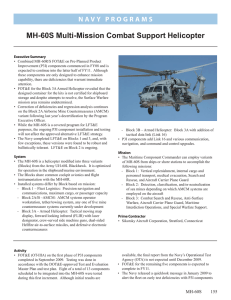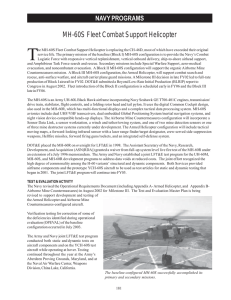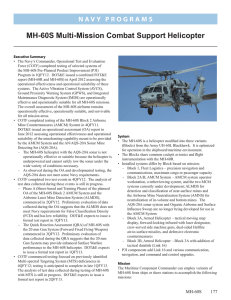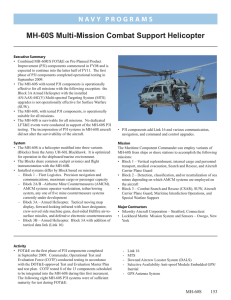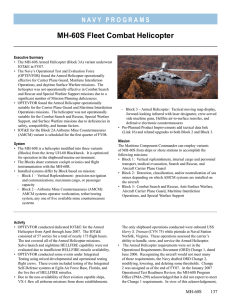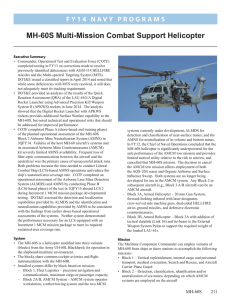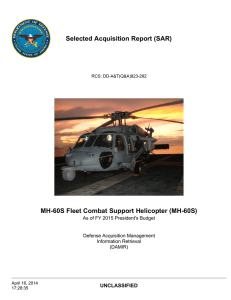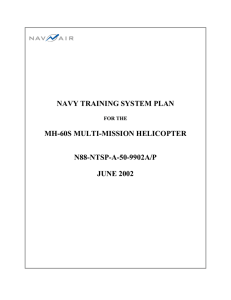MH‑60S Multi‑Mission Combat Support Helicopter
advertisement
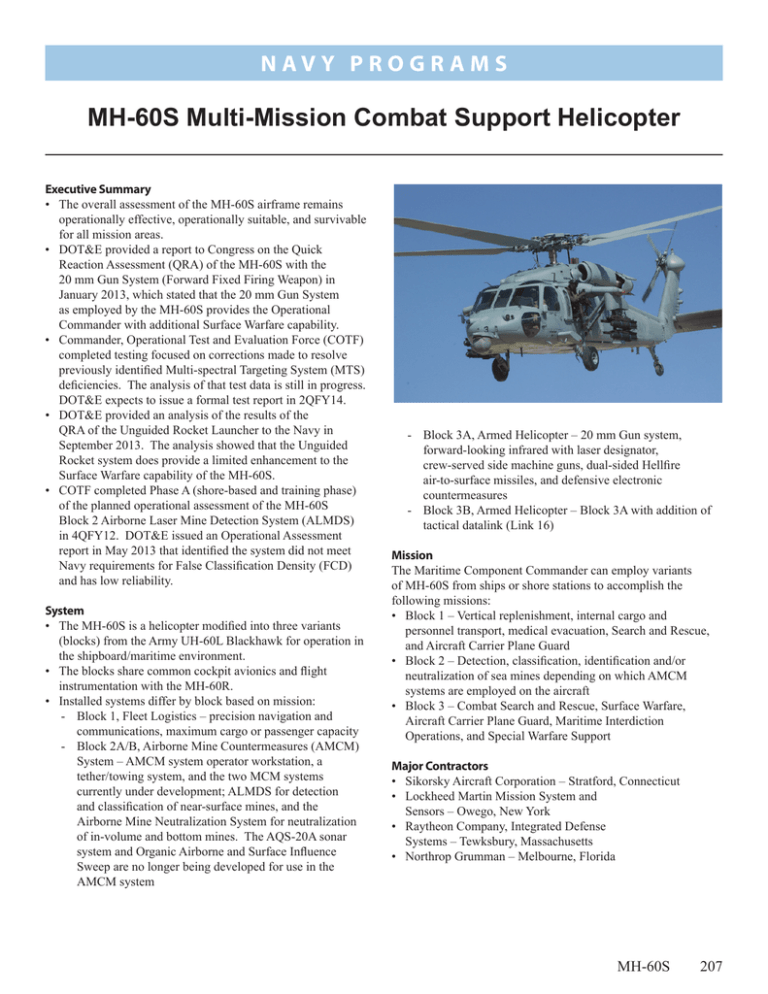
N av y P R O G R A M S MH-60S Multi-Mission Combat Support Helicopter Executive Summary • The overall assessment of the MH-60S airframe remains operationally effective, operationally suitable, and survivable for all mission areas. • DOT&E provided a report to Congress on the Quick Reaction Assessment (QRA) of the MH-60S with the 20 mm Gun System (Forward Fixed Firing Weapon) in January 2013, which stated that the 20 mm Gun System as employed by the MH-60S provides the Operational Commander with additional Surface Warfare capability. • Commander, Operational Test and Evaluation Force (COTF) completed testing focused on corrections made to resolve previously identified Multi-spectral Targeting System (MTS) deficiencies. The analysis of that test data is still in progress. DOT&E expects to issue a formal test report in 2QFY14. • DOT&E provided an analysis of the results of the QRA of the Unguided Rocket Launcher to the Navy in September 2013. The analysis showed that the Unguided Rocket system does provide a limited enhancement to the Surface Warfare capability of the MH-60S. • COTF completed Phase A (shore-based and training phase) of the planned operational assessment of the MH-60S Block 2 Airborne Laser Mine Detection System (ALMDS) in 4QFY12. DOT&E issued an Operational Assessment report in May 2013 that identified the system did not meet Navy requirements for False Classification Density (FCD) and has low reliability. System • The MH-60S is a helicopter modified into three variants (blocks) from the Army UH-60L Blackhawk for operation in the shipboard/maritime environment. • The blocks share common cockpit avionics and flight instrumentation with the MH-60R. • Installed systems differ by block based on mission: - Block 1, Fleet Logistics – precision navigation and communications, maximum cargo or passenger capacity - Block 2A/B, Airborne Mine Countermeasures (AMCM) System – AMCM system operator workstation, a tether/towing system, and the two MCM systems currently under development; ALMDS for detection and classification of near-surface mines, and the Airborne Mine Neutralization System for neutralization of in‑volume and bottom mines. The AQS-20A sonar system and Organic Airborne and Surface Influence Sweep are no longer being developed for use in the AMCM system - Block 3A, Armed Helicopter – 20 mm Gun system, forward-looking infrared with laser designator, crew‑served side machine guns, dual-sided Hellfire air-to-surface missiles, and defensive electronic countermeasures - Block 3B, Armed Helicopter – Block 3A with addition of tactical datalink (Link 16) Mission The Maritime Component Commander can employ variants of MH-60S from ships or shore stations to accomplish the following missions: • Block 1 – Vertical replenishment, internal cargo and personnel transport, medical evacuation, Search and Rescue, and Aircraft Carrier Plane Guard • Block 2 – Detection, classification, identification and/or neutralization of sea mines depending on which AMCM systems are employed on the aircraft • Block 3 – Combat Search and Rescue, Surface Warfare, Aircraft Carrier Plane Guard, Maritime Interdiction Operations, and Special Warfare Support Major Contractors • Sikorsky Aircraft Corporation – Stratford, Connecticut • Lockheed Martin Mission System and Sensors – Owego, New York • Raytheon Company, Integrated Defense Systems – Tewksbury, Massachusetts • Northrop Grumman – Melbourne, Florida MH-60S 207 N av y P R O G R A M S Activity • COTF conducted the following test events in accordance with a DOT&E-approved test plan: - A QRA of the MH-60S with the 20 mm Gun System (Forward Fixed Firing Weapon) in 3QFY12 - FOT&E focused on corrections made to resolve previously identified MTS deficiencies from 4QFY12 to 2QFY13 - A QRA of MH-60S with the LAU 61C/A Unguided Rocket Launcher during 2Q-3QFY13 - Phase A (shore-based and training phase) of the planned operational assessment of the MH-60S Block 2 ALMDS in 4QFY12 • DOT&E issued an Operational Assessment report in May 2013 that identified the system did not meet Navy requirements for FCD and has low reliability. The Navy intends to conduct Phase B (Littoral Combat Ship (LCS) Ship-based phase) of the operational assessment in conjunction with the MCM mission package Developmental Test Phase 4 Period 2 on the Independence variant seaframe that is scheduled to occur in 4QFY14-1QFY15. • All LFT&E activities were completed and reported in the Combined OT/LFT&E report to Congress in 2008. Assessment • DOT&E submitted a test report to Congress for the QRA of MH-60S with the 20 mm Gun System (Forward Fixed Firing Weapon) in January 2013. The 20 mm Gun System provides enhanced Surface Warfare performance to the MH‑60S helicopter. The complete details of the evaluation are classified. • Preliminary analysis of test data collected during testing of the upgraded software for MTS on the MH-60S indicates that most of the deficiencies identified during previous test events have been resolved. Testing was limited in scope and did not support an assessment of the Surface Warfare mission capability of MH-60R when equipped with MTS and the Hellfire missile. DOT&E expects to issue a formal test report in 2QFY14. • DOT&E provided an analysis of the results of the QRA of the Unguided Rocket Launcher to the Navy in September 2013. Testing demonstrated that proper employment of the Unguided 208 MH-60S Rocket Launcher on the MH-60S may assist the Operational Commander in executing the Surface Warfare mission. • DOT&E assessed that the MH-60S helicopter equipped with the ALMDS cannot be operationally effective until ALMDS detection and classification performance is improved. ALMDS did not demonstrate the required rapid mine reconnaissance rate, did not detect mines at depths and percentage required, and did not meet the Navy’s requirements for FCD. To mitigate the FCD problem, the Navy devised alternate tactics requiring multi-passes and reacquisition attempts that adversely affect the area coverage rate sustained (ACRS). ACRS is a key measure of LCS effectiveness in MCM operations. • DOT&E assessed that ALMDS cannot be operationally suitable until its reliability is improved. System performance is degraded by numerous nuisance faults and periodic mission critical failures. Persistent faults delayed missions and required flight crews to search areas and revisit contacts multiple times. The test team replaced the system 4 times to complete a total of 16 minehunting missions. The high-failure rate will impose additional logistics burdens to support LCS MCM operations. Recommendations • Status of Previous Recommendations. The Navy has partially addressed the FY12 recommendation by conducting FOT&E to assess corrections made to resolve previously identified MTS deficiencies. The Navy still needs to address the FY11 recommendation to investigate solutions and correct the ALMDS FCD and reliability deficiencies prior to IOT&E. • FY13 Recommendations. The Navy should: 1. Separately complete comprehensive survivability studies for the MH-60S employing the 20 mm Gun System and the Unguided Rocket Launcher. 2. Conduct comprehensive live fire lethality testing of the Hellfire missile against a complete set of threat representative small boat targets. 3. Test the Surface Warfare mission capability of MH-60S equipped with Hellfire missiles.
